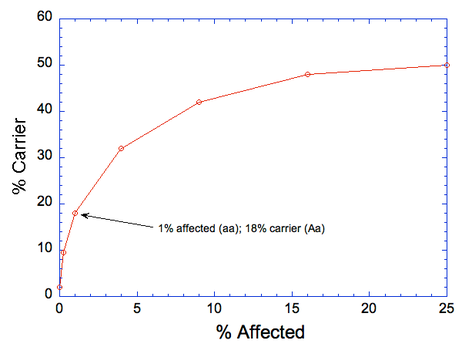
Most genetic disorders in dogs are caused by single, autosomal recessive mutations. These are genes that somewhere along the line were copied improperly or damaged somehow, but have no ill effects as long as the animal has a copy of the normal gene. These mutations can lurk in the genome for generations, passed on just like any other gene, and never causing a problem as long as they are bachelors.
But if an animal inherits two copies of the mutation, it won't have a copy of the normal gene so whatever function that gene had won't be done properly. Perhaps it's something relatively trivial (e.g., ability to curl your tongue while whistling) that doesn't matter much to the animal's success at reproducing, but it can also be something serious, in which case it counts as a "genetic disease".
The list of these inherited diseases caused by single mutations seems to grow every day, and in fact you can keep track of the tally on a database called "Online Mendelian Inheritance in Animals".
The problem with these diseases caused by recessive mutations is that they sneak up on you. Affected animals are homozygous for the allele, but there will be animals that carry the mutation, are heterozygous for the allele, that will have no symptoms. These of course are the so-called "carriers", and carry is exactly what they do. These animals sneaking around in the population are just one allele away from producing offspring with a particular genetic disorder, and the more carriers there are in a population the more likely one carrier is to bump into another and produce homozygous, affected offspring.
Genetic disorders in dogs caused by these recessive mutations usually seem to "suddenly" appear. The problem has never been seen in a breed, then a few dogs turn up affected but nobody gets too excited, then more dogs are are appearing, and finally breeders recognize that this particular disorder is becoming "a problem" in their breed.
Unfortunately, by the time alarm is raised, the mutation can be widespread in the breed. We can use the Hardy-Weinberg equation to get a rough idea of how widespread a recessive mutation is in a population. H-W tells us how the frequency of homozygous and heterozygous genotypes change with the frequency of one of the two alleles. This is a graph of the estimated frequency of carriers of a recessive mutation based on the frequency of affected dogs that are observed. What you see here should be very worrisome.
When the frequency of affected dogs (aa) in a population is 1% - e.g., that's only three dogs in a population of three hundred - the frequency of carriers (Aa) is already almost 20%. Three dogs in 300 with a particular health issue would never be recognized by breeders as an impending crisis. It's "just one of those things" or a bit of bad luck. Not knowing how the problem is inherited, breeders are unlikely to connect the dots, and in any case the number of affected cases would need to be much higher before a pedigree analysis would be very informative.
So, most recessive mutations are not detected until the number of affected animals is high enough to get everybody's attention. How high would that need to be? Well, if it's 5% affected, the fraction of carriers is already about 35%; if it's 1 in 10 dogs, the carrier frequency is over 40%. Dealing with a nasty mutation that is carried by more than about 20% of a breed is extremely difficult and takes the cooperation of many breeders if the problem is going to be managed in the breed as a whole. (Of course, some breeders will hunker down and stay within their own lines, which they assume to be "safe", but of course unknown mutations are lurking in every animal and sooner or later one will become a problem.) But if the problem isn't noticed until the carrier frequency is 40%, well then you've got yourselves a real problem.
EVERY dog has recessive mutations. To cause a problem, a recessive mutation must find a mate, and the best place to find that is in a close relative that shares many of your genes. The very reason breeders inbreed - to get two copies of the same allele for desirable traits - is the very reason the number of genetic disorders in dogs will continue to rise. And as a breeder gets more and more consistency in the traits they want by increasing the amount of genetic homozygosity in their dogs, they also get a greater and greater risk of fixing the genes for some heretofore unknown genetic problem. You can't increase homozygosity for the genes you want by breeding to related dogs without also increasing the homozygosity of the genes you don't. This is a real bummer, but it's just math.
Estimates of carrier rates using H-W aren't perfect. There are underlying assumptions that are definitely violated in purebred dog populations (such as "no selection"), and the dogs certainly are not bred randomly. But in general, the situation in dog breeds is likely to be worse than predicted by H-W because breeders tend to select dogs to breed to that have a HIGHER than average chance of sharing mutations (compared to a dog chosen at random) because they're related.
Go back and scan the last health survey of your breed. Notice any problems that are so uncommon that nobody is worrying about them? The odd PRA here, a case or two of degenerative myelopathy, perhaps a few dogs with cerebellar ataxia or myasthenia gravis, but not in any dogs that you know. Think about this the next time a breeder says of a genetic disorder "Oh, that's not been a problem in our breed." The seeds of the next problem are already sown.
And join the discussion in our FACEBOOK GROUP - ICB Breeding for the Future

